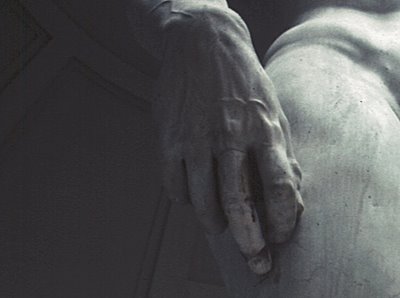'Life' into 'Art' - From Photography to Drawing

For me, it's interesting to consider how an artist (of whatever persuasion - photographer, painter, sculptor, etc) transmutes the stuff of his world into a work of art.
There seems to be various stages in this transformation.
There is perhaps the initial selection of things from the world and the arrangement of them in a chosen setting. To give a 'composition' to work from - with a particular balance of forms, colours, textures, etc.
(There is of course the philosophical question - so nicely put by E M Forster in 'Maurice' (?) - of whether the world in fact exists at all in its own right, but only when we observe it. In the opening of that novel, students sit around in their digs at Cambridge Uni and consider whether a cow in a field is still there when not being seen.)
Okay then, so this 'composition' then is the basic material for the work of art.
There are then decisions to be made about how to transmute this composition into art.
In photography, choices about lighting, and the angle to and distance from the camera to be considered. The kind of film used to be determined - depending on the degree of graininess or sharpness, etc desired. And so on and so on. The following is the formally beautiful result of some unusual choices of lighting and composition - for example, the light source from the landing, and at least half the major elements exterior to the room:
In drawing, there are a number of additional choices to be made. So, what is to be exaggerated, omitted, added, changed around, ... . Rather than simply reproduce the composition in front of the artist.
In the 'Adonis' (Artist Unknown) drawing, a number of choices have been made - some more successful, some less.
The background setting, which in the photo is somewhat distracting, has been eliminated. The figure now stands out - its forms and details much clearer and observable.
The slight awkwardness of the inward-turning right leg in the photograph has been 'corrected' in the drawing. And the legs have been extended down - making the composition more formally balanced. All of which results in the cutie's legs more spread, and better framing/presenting his cock and balls!
Talking of which, the drawing happily gives us two balls, to eradicate any possibility of partial castration confusion in the photo. And a much fatter and longer dick. A good choice to my mind! Not sure about the motivation, oh yeah!
Surprisingly, some artists go the other way, like Michelangelo's choice in his painting of Adam in the Sistine Chapel's frescoed ceiling (1508-12):

In fact, this choice was symbolically motivated - Michelangelo was depicting the moment before God gave life to Adam.
The 'Adonis' artist was obviously not motivated by the painters's high-minded symbolism!
One of our artist's less successful choices (or a limitation of technique?) was to leave out the veins captured in the guy's left bicep, forearm and hand in the photo. This leaves the young bloke a bit less than pulsing with life.
Consider Michaelangelo's success in his 'David' (1504) in this respect:

in the detail, for example, of the veins in the youth's right hand:

Despite all of this, the 'Adonis' is a lovely drawing in that it captures the real sense of a self-consciously beautiful person, abeit from a photograph. As such, it is perhaps not a real work of art in its own right, in the sense of not going much beyond reproducing another's image.
But if anyone knows who made the drawing, I'd love to know.



![C18 Bronze Buddha [Southern China]](https://blogger.googleusercontent.com/img/b/R29vZ2xl/AVvXsEioLkgVKuhDoIHQgM1X6Oe2hGn75yqaj4OJXPmNpumXmQPKxB22S57YS5DVrl1P7zl7BS6EFpAtaNZPze7gzVCRiQI54bwdHhVa4fGr7NOChZwTZoo92gUen6tC5U8gWIy_pv92U0FB38M/s1600/Buddha+%255BBronze%252C+C18%252C+China%255D+1.jpg)













+1998+Cropped.jpg)












No comments:
Post a Comment